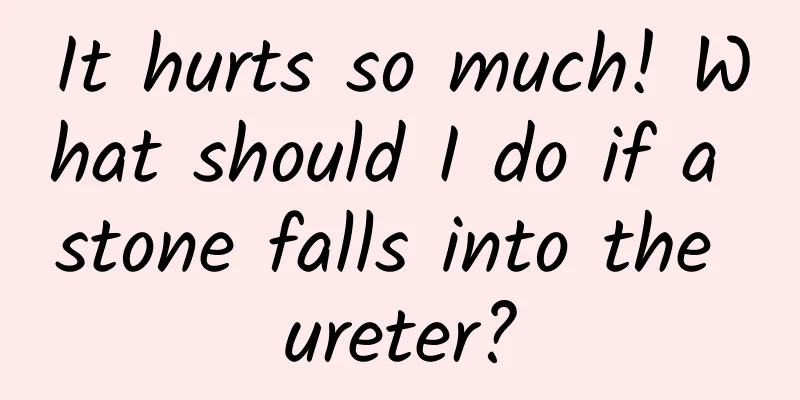It hurts so much! What should I do if a stone falls into the ureter?

|
1. What are ureteral stones? Ureteral stones are one of the common diseases in urology. More than 90% of ureteral stones are caused by kidney stones moving down to the ureter. Ureteral stones are rare. They are often formed due to ureteral stenosis, deformity and other reasons that cause obstruction of a certain section of the ureter, and certain components in the urine are deposited at the obstruction. Therefore, the composition of ureteral stones is roughly the same as that of kidney stones. 2. What are the components of ureteral stones? 1. According to the cause: (1) Metabolic stones: related to abnormal metabolism of oxalate, calcium, uric acid, citrate, cystine, etc. in the human body, such as hyperoxaluria, primary hyperparathyroidism, sarcoidosis, malignant tumors, etc. (2) Infectious stones: Stones are formed by urease-producing bacteria that decompose urea, providing an alkaline urine environment and sufficient concentrations of carbonic acid and ammonia. (3) Drug-induced stones: These are caused directly by the precipitation and crystallization of drugs or their metabolites in urine, or indirectly by drugs changing the urine environment, such as ceftriaxone sodium, vitamin D, etc. 2. According to crystal composition: (1) Calcium-containing stones: calcium oxalate stones, calcium phosphate/carbonate apatite, and calcium carbonate stones. (2) Non-calcium stones: cystine stones, xanthine stones, urea/urate stones, ammonium magnesium phosphate stones, matrix stones/cellulose stones. 3. What are the diagnostic methods for ureteral stones? 1. Laboratory tests: blood analysis, urine analysis and stone analysis. 2. Imaging examinations: ultrasound examination, urinary tract X-ray, intravenous urography, CT examination, retrograde or percutaneous renal puncture, magnetic resonance imaging, and radionuclide. 4. What are the treatments for ureteral stones? 1. Drug treatment in the acute phase: anti-infection (diclofenac sodium, indomethacin, etc.); analgesia (hydromorphone, pentazocine, etc.); antispasmodics (atropine sulfate, scopolamine, etc.). 2. Non-surgical treatment: About 75% of ureteral stones with a diameter of less than 5 mm can be discharged on their own. Non-surgical treatment is the first choice, including: drinking a lot of water (2500-3000 ml/day); moderate exercise; appropriate use of analgesics to relieve renal colic symptoms. For stones with a diameter of 5-10 mm, non-surgical treatment can be selected under close monitoring, and the follow-up observation time should be within one month. 3. Surgical treatment: When the stone diameter is greater than 10 mm or persistent ureteral obstruction or infection occurs during the observation period, and there is no obvious progress in the natural stone excretion process, surgical treatment should be considered, mainly including: shock wave lithotripsy, ureteroscopic lithotripsy, percutaneous nephrolithotomy, laparoscopic lithotripsy and open surgery. 5. How to prevent ureteral stones? (1) Drink more water. (2) Normal calcium diet: The recommended daily calcium intake for adults is 1-1.2g. (3) Limit the intake of excessive animal protein, high purine, oxalic acid and sodium salt, and increase the intake of fruits, vegetables, whole grains and fiber. (4) Moderate exercise and weight loss for obese people. References: 1. Editorial Department of Journal of Urology (Electronic Edition). Interpretation of the Guidelines for the Diagnosis and Treatment of Urinary Stones (I)[J]. Journal of Urology (Electronic Edition), 2010, 2(4):56-57. DOI:10.3969/j.issn.1674-7410.2010.04.017. 2. Editorial Department of Journal of Urology (Electronic Edition). Interpretation of the Guidelines for the Diagnosis and Treatment of Urinary Stones (II): Treatment of Kidney Stones[J]. Journal of Urology (Electronic Edition), 2012, 4(1): 46-48. DOI: 10.3969/j.issn.1674-7410.2012.01.014. 3. Guo Yinglu, Na Yanqun, Ye Zhangqun, et al. "Guidelines for the diagnosis and treatment of urological and men's diseases in China" |
Recommend
This generation of young people rely on "sound massage" to help them sleep
Difficulty falling asleep, shallow sleep, dreamin...
Holding a green bamboo stick in hand, I travel thousands of miles
According to the latest statistical report, my co...
Symptoms of fetal hypoxia at 23 weeks of pregnancy
After pregnancy, a small life will appear in the ...
Can I have abortion by myself?
Some women have to choose abortion after accident...
What causes excessive menstrual blood clots?
Adult women normally have their menstrual period ...
Can I drink beer after abortion?
Artificial abortion will cause certain harm to th...
Why does the right side of a woman's belly button hurt?
Women are very likely to suffer from stomach pain...
Can you still live a wonderful life after menopause?
This is the 4277th article of Da Yi Xiao Hu Peopl...
What Chinese medicine is best for irregular menstruation?
Irregular menstruation is a disease that female f...
30 days after delivery, there is fresh blood but not much
After giving birth, women will be very weak and w...
Why does a woman’s period have an odor?
For women, menstruation is a normal physiological...
How to regulate blood deficiency in women
Both men and women can suffer from diseases such ...
What are the benefits and functions of navel oranges? How long can a cut navel orange be kept?
In the fruit world, the bright yellow navel orang...
Breast excision surgery
The breast is the most vulnerable part of the bod...
From leaves to skin, the whole body is full of treasures. Eat this fruit quickly! But these types of people should not be greedy!
Ripe pomegranate Each one is as plump as a ruby T...









